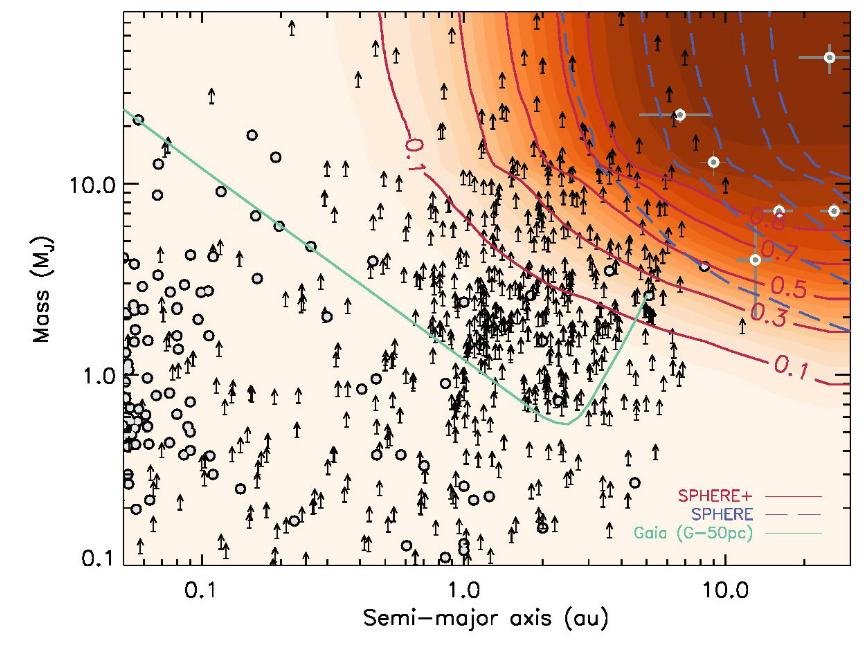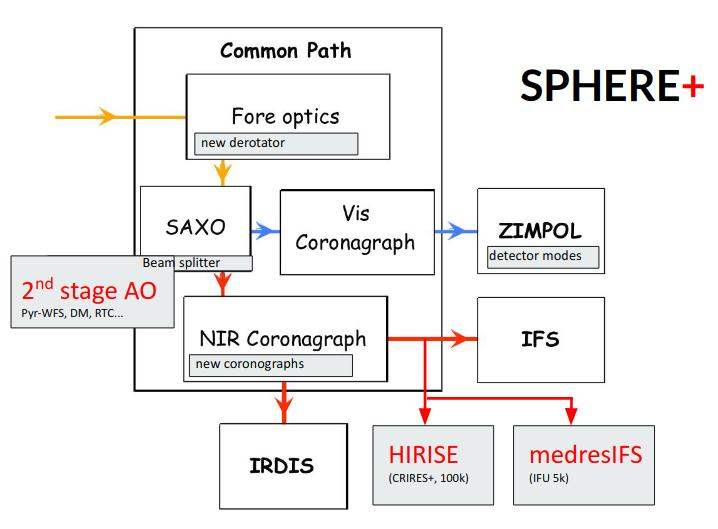Description & Scientific motivation

The Spectro-Polarimetric High-contrast Exoplanet REsearch instrument (SPHERE, Beuzit et al 2019) has now been in operation at the VLT for more than 5 years, demonstrating a high level ofperformance. SPHERE has produced outstanding results using a variety of operating modes, primar-ily in the field of direct imaging of exoplanetary systems, focusing on exoplanets as point sources andcircumstellar disks as extended objects. The achievements obtained thus far with SPHERE (∼200 refereed publications) in different areas (exoplanets, disks, solar system, stellar physics...) have motivated a large consortium to propose an even more ambitious set of science cases, and its correspondingtechnical implementation in the form of an upgrade. The SPHERE+ project capitalizes on the exper-tise and lessons learned from SPHERE to push high contrast imaging performance to its limits on the VLT 8m-telescope. The scientific program of SPHERE+ described in this document will open a newand compelling scientific window for the upcoming decade in strong synergy with ground-based facil-ities (VLT/I, ELT, ALMA, and SKA) and space missions (Gaia, JWST, PLATO and RST). While SPHERE has sampled the outer parts of planetary systems beyond a few tens of AU, SPHERE+ will dig into the inner regions around stars to reveal and characterize by mean of spectroscopy the giantplanet population down to the snow line. Building on SPHERE’s scientific heritage and resounding success, SPHERE+ will be a dedicated survey instrument which will strengthen the leadership of ESO and the European community in the very competitive field of direct imaging of exoplanetary systems. With enhanced capabilities, it will enable an even broader diversity of science cases including the study of the solar system, the birth and death of stars and the exploration of the inner regions of active galactic nuclei. Therefore, the main motivation for SPHERE+ relies on three key scientific requirements that are currently driving this project as well as our proposed instrumental concept.
In this context, together with the SPHERE+ consortium, I am currently pushing this endeavor as Project Scientist of the project to achieve a first light in 2025. The scientific goals of SPHERE+ can be summarized as follow:
-
Access the bulk of the young giant planet population down to the snow line (3-10 au), in order to bridge the gap with complementary techniques (radial velocity, astrometry), taking advantage of the synergy withGaia, and to explore for the first time the complete demographics of young giant planets at all separations in order to constrain their formation andevolution mechanisms.
-
Observe a large number of fainter (lower mass) stars in the youngest (1−10Myr) associations (Lupus, Taurus, Chamaeleontis, Scorpius-Centaurus...), to directly study the formation of giant planets in their birth environment, building on the synergy with ALMA to characterize the architectures and properties of young protoplanetary disks, and how theyrelate to the population of planets observed around more evolved stars.
-
Improve the level of characterization of exoplanetary atmospheres by increasing the spectral resolution in order to break degeneracies in giant planet atmosphere models and to measure abundances and other physical parameters, such as the radial and rotationalvelocities. Near-infrared will be the primary wavelength range utilized, but the visible rangealso delivers valuable information in the form of accretion tracers.
Concept

The SPHERE+ top level requirements connected to the proposed science goals can be summarized by going closer, deeper, and fainter. They directly drive the following instrumental requirements and upgrades of the SPHERE instrument:
-
Deeper & closer: increase the bandwidth of the xAO system (typically 3kHz instead of 1kHz) with a second stage near-infrared AO system, combined with the improvement of the correction of non-common path aberrations and coronagraphic rejection.
-
Fainter: include a more sensitive Pyramid-infrared wavefront sensor to gain 2-3 magnitudes for red stars.
-
Enhanced characterization: develop spectroscopic facilities with significantly higher spectral resolution compared to the current SPHERE Integral Field Spectrograph (IFS). In this respect, both medium (Rλ= 5000−10 000) and high (Rλ= 50 000−100 000) resolutions are extremely valuable for the characterization of planetary atmospheres.
The SPHERE+ concept relies on three main sub-systems:
-
SAXO+:As a second stage to be implemented in the current AO path, the new module SAXO+ takes short wave-length photons in the SAXO-corrected NIR path, and provides an additional faster-finer correctionto the science instruments. The second stage includes its own specialized DM (with high speed butrelaxed stroke requirements), sensor, and fast control law. This consistency with the existing AOsystem allows forstand alone development and test in Europe, fed with well known SAXO correc-tion residuals, before implementation on SPHERE.
-
medresIFS: A medium resolution integral field spectrograph will be a major addition to SPHERE and is needed to address the science requirements related primarily to exoplanets. We aim to achieve spectral resolution of at least Rλ= 5000 consistent with the molecular mapping technique. The baseline design consists of a diffraction-limited IFU based on single-mode fibers or a single multi-core fiber covering the J and H-bands where standard silica fibers are commercially available. The high fiber transmission allows the spectrograph to be placed at a remote location. The fiber head itself can belocated on the back side of the platform being built for HiRISE, thereby minimizing the impact on SPHERE. A fiber-fed spectrograph can also be combined with a dedicated apodizer that maximizes the coupling efficiency of off-axis point sources while suppressing the central star (Por & Haffert2018; Haffert et al. 2018a). Comparison with alternative IFU schemes (lenslets/image slicers) will be performed. The IFU will feed one or several compact spectrographs with NIR detectors withlow read-out noise and low dark current.
-
HiRISE: This sub-system will implement a novel fiber coupling between SPHERE and CRIRES+ to leverage the performance capabilities of both instruments. A self-contained fiber injection module (FIM) will be installed in SPHERE downstream of the coronagraph to pick-up the planetary signal and inject it to CRIRES+ through a fiber relay. Wavefront control using the ZELDA wavefront sensor installed in SPHERE will be used to optimize the injection at the entrance of the fiber and maximize the planetary signal transmission. In CRIRES+, a fiber extraction module (FEM) will be implemented in the calibration stage already available in the warm part at the entrance of the instrument.
The Consortium
Management: Anthony Boccaletti (PI/LESIA), Gaël Chauvin (Project Scientist/IPAG), David Mouillet & Julien Milli (Instrument Scientist/IPAG), François Wildi (Obs. Geneva), Magali Loupias (System Engineer/CRAL), Jean-Luc Beuzit (SPHERE PI/LAM), AO Scientists (Fabrice Vidal/LESIA & Faustine Cantalloube/LAM), Predictive Control (Markus Kasper/ESO), MEDRES Scientists (Christoph Keller/Leiden & Raffaele Gratton/INAF-OAPD), MEDRES Trade-off (Mickael Bonnefoy/IPAG), HiRISE SPHERE-CRIRES+ upgrade (Arthur Vigan PI/LAM), ZIMPOL upgrade (H.-M. Schmid/ETHZ), NCPA/Corono (Mamadou N'Diaye/Lagrange & Johan Mazoyer/LESIA), Data Analysis (Maud Langlois/CRAL)...
Institutes: LESIA, IPAG, LAM, CRAL, Lagrange (INSU/France), Osservatorio di Padova, Bologna, Roma (INAF/Italy), Bern University, ETHZ & Geneva Observatory (PlanetS/Switzerland), MPIA (Germany), Leiden & Amsterdam Universities (NOVA/Netherlands), Liège University (Belgium), Stockholm University (Sweden) & Royal Observatory of Edinburgh (UK).





